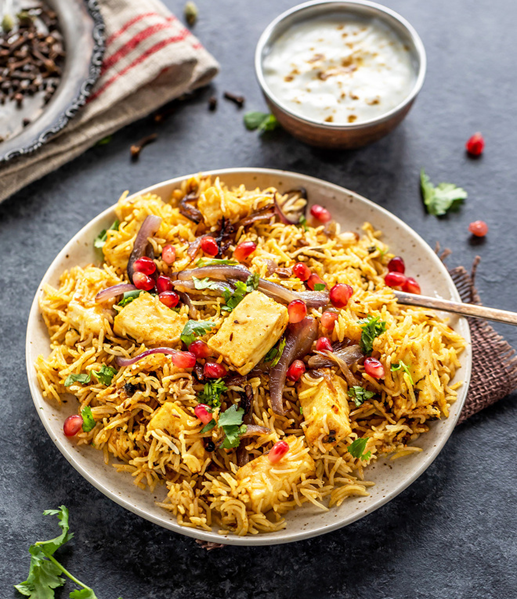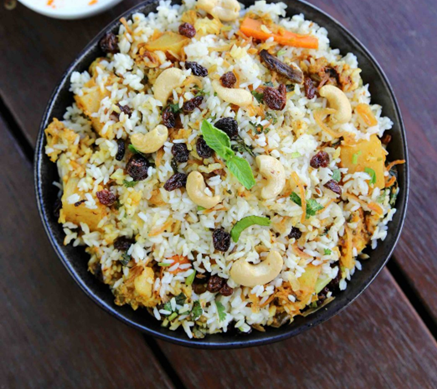The Historical Tapestry of Biryani

Biryani, a rich and aromatic rice dish, has a long and fascinating historical tapestry that weaves together various culinary traditions, cultural exchanges, and regional flavors. Its origins can be traced back centuries ago, and it has evolved and flourished in different parts of the world, leaving a flavorful mark on the culinary landscape.
The exact origins of biryani are a subject of debate among food historians, as its history is interwoven with the complex tapestry of ancient trade routes and cultural exchanges in the Indian subcontinent.
One theory suggests that biryani is derived from the Persian dish “biryan,” which means “fried before cooking” or “roasted.” The Persian influence on Indian cuisine, especially during the Mughal era, played a significant role in shaping the flavors and techniques of biryani.
The Mughal Empire, which ruled over the Indian subcontinent from the 16th to the 18th centuries, is often credited with popularizing biryani in the region. The Mughal emperors were known for their opulent lifestyle and their love for indulgent, flavorful dishes.
Biryani became a part of their royal feasts, with each emperor adding their unique touch to the dish. The royal kitchens of the Mughals experimented with different ingredients, spices, and cooking techniques, resulting in the creation of several regional variations of biryani.
As the Mughal Empire declined, biryani spread beyond the royal courts and became a beloved dish among the general population. It found its way into the kitchens of the nawabs (nobles) of Awadh (present-day Lucknow) and the Nizams of Hyderabad, who further refined and elevated the art of biryani-making. The Awadhi biryani, characterized by its fragrant long-grain rice, tender meat, and delicate flavors, is known for its slow cooking method known as “dum pukht.”
However, it is worth mentioning that vegetarian and vegan diets have been gaining popularity in recent years due to increasing awareness of health, environmental sustainability, and ethical concerns. This has led to a growing demand for vegetarian and vegan options in various cuisines, including biryani.
Veg biryani, with its rich flavors and aromatic blend of spices, can cater to the preferences of those following a vegetarian or vegan lifestyle. Many restaurants and food establishments have recognized this demand and have started offering a wide range of veg biryani options to accommodate the growing trend of plant-based eating.
Here are some popular types of veg biryani:
Hyderabadi Veg Biryani

Originating from Hyderabad, India, this biryani is known for its spicy flavors. It combines basmati rice with vegetables like carrots, peas, beans, potatoes, and cauliflower.
Lucknowi Veg Biryani

Hailing from the Awadh region in India, Lucknowi biryani is known for its subtle flavors and delicate aroma. It is a dum-style biryani, prepared by slow cooking basmati rice and vegetables spiced up with saffron, rose water, ghee (clarified butter), and a blend of mild spices such as nutmeg, mace, and fennel,cooked in a sealed pot.
Malabar Veg Biryani

Originating from the Malabar region in the southern state of Kerala, Malabar biryani showcases the influence of the region’s rich culinary heritage. It combines fragrant rice with an array of vegetables, coconut milk, and a medley of spices like black pepper, cloves, cinnamon, and star anise.
The influence of biryani extended beyond the Indian subcontinent. With the expansion of trade and colonization, biryani traveled to other parts of the world, leaving its imprint on local cuisines. The Arab world has its own interpretation of biryani, influenced by the Indian and Persian styles. The Persian Gulf countries, particularly Kuwait and the United Arab Emirates, have embraced biryani as a popular dish, incorporating local flavors and ingredients such as saffron and dried fruits.
In Southeast Asia, countries like Malaysia and Indonesia have their own versions of biryani, influenced by Indian and Middle Eastern flavors. Nasi briyani in Malaysia and nasi kebuli in Indonesia are examples of how biryani has been adapted and integrated into local culinary traditions.
Today, biryani continues to be a beloved dish enjoyed by millions worldwide. It has transcended boundaries and cultures, representing a beautiful amalgamation of flavors, techniques, and traditions. Whether it’s the royal biryanis of Lucknow or the spicy delights of Hyderabad, the historical tapestry of biryani showcases the rich culinary heritage and the vibrant diversity




